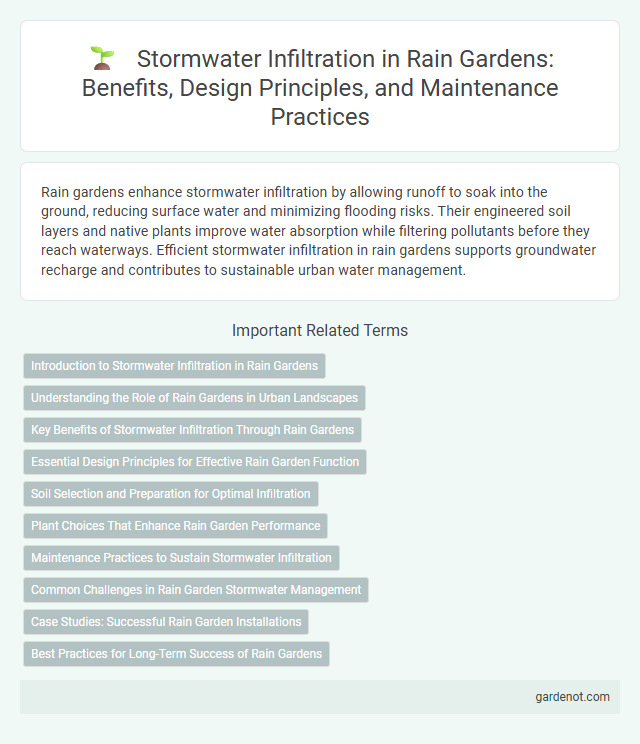Rain gardens enhance stormwater infiltration by allowing runoff to soak into the ground, reducing surface water and minimizing flooding risks. Their engineered soil layers and native plants improve water absorption while filtering pollutants before they reach waterways. Efficient stormwater infiltration in rain gardens supports groundwater recharge and contributes to sustainable urban water management.
Introduction to Stormwater Infiltration in Rain Gardens
Stormwater infiltration in rain gardens involves capturing and allowing runoff to percolate into the soil, reducing surface flooding and recharging groundwater. Engineered layers of mulch, soil, and native plants enhance infiltration rates and filter pollutants from stormwater. This natural process mitigates urban runoff impacts while promoting sustainable water management systems.
Understanding the Role of Rain Gardens in Urban Landscapes
Rain gardens significantly enhance stormwater infiltration by capturing runoff from impervious surfaces such as roads and rooftops, allowing it to percolate into the soil rather than overwhelming urban drainage systems. These gardens utilize native vegetation and engineered soil layers that increase permeability and filter pollutants, reducing the volume and improving the quality of stormwater entering groundwater and nearby water bodies. Effective stormwater management with rain gardens mitigates urban flooding, replenishes aquifers, and supports sustainable urban landscape resilience.
Key Benefits of Stormwater Infiltration Through Rain Gardens
Rain gardens significantly enhance stormwater infiltration by allowing rainwater to percolate through vegetation and soil, reducing surface runoff and decreasing the risk of urban flooding. This process helps recharge groundwater aquifers, improving water quality by filtering pollutants such as sediments, nutrients, and heavy metals before they enter natural waterways. Effective stormwater infiltration in rain gardens also mitigates erosion and supports sustainable urban drainage systems, contributing to resilient and green urban environments.
Essential Design Principles for Effective Rain Garden Function
Rain garden stormwater infiltration relies on well-drained soil media with a high infiltration rate, typically between 0.6 to 1.2 inches per hour, to prevent surface runoff and promote groundwater recharge. Incorporating native vegetation with deep-rooted plants enhances soil structure and maximizes water absorption while reducing pollutants. Proper grading and an underdrain system ensure efficient water flow and prevent waterlogging, maintaining optimal rain garden performance during heavy rain events.
Soil Selection and Preparation for Optimal Infiltration
Selecting well-draining, sandy loam soil with high organic matter enhances stormwater infiltration by promoting pore space and microbial activity. Soil preparation involves loosening compacted layers to improve permeability and incorporating amendments like compost to increase water retention and nutrient availability. Properly prepared soil reduces runoff and supports healthy vegetation, optimizing the rain garden's stormwater management function.
Plant Choices That Enhance Rain Garden Performance
Selecting deep-rooted native plants such as switchgrass (Panicum virgatum) and blue flag iris (Iris versicolor) enhances stormwater infiltration by promoting soil aeration and permeability in rain gardens. These species improve microbial activity and organic matter decomposition, which increases the soil's capacity to absorb and filter water efficiently. Incorporating diverse plant varieties with varying root structures maximizes infiltration rates and supports sustainable stormwater management.
Maintenance Practices to Sustain Stormwater Infiltration
Effective maintenance practices for rain gardens are essential to sustain stormwater infiltration and prevent clogging of soil media. Regular inspection and removal of accumulated debris, sediment, and invasive vegetation ensure optimal permeability and water absorption rates. Periodic replenishment of mulch and replenishing native plants support infiltration by enhancing soil structure and promoting healthy root growth.
Common Challenges in Rain Garden Stormwater Management
Stormwater infiltration in rain gardens often faces challenges such as soil compaction, which reduces permeability and limits water absorption capacity. Clogged inlet and outlet structures due to sediment accumulation can impede water flow, causing overflow or stagnation. Vegetation selection also impacts infiltration rates, as certain plants with deep root systems enhance soil permeability while others may contribute to surface runoff.
Case Studies: Successful Rain Garden Installations
Studies from Seattle and Portland demonstrate that rain gardens can reduce stormwater runoff by up to 90%, significantly improving groundwater recharge and minimizing urban flooding. In New York City, a rain garden installed in a public park captured over 10,000 gallons of stormwater per year, showcasing effective infiltration in dense urban areas. These case studies highlight rain gardens' capacity to enhance stormwater management through natural filtration and infiltration processes.
Best Practices for Long-Term Success of Rain Gardens
Effective stormwater infiltration in rain gardens is achieved through selecting native plants with deep root systems that enhance soil permeability and prevent clogging. Incorporating a well-graded soil mix composed of sand, compost, and topsoil optimizes water absorption and nutrient filtration. Regular maintenance, including sediment removal and monitoring for soil compaction, ensures sustained infiltration capacity and long-term functionality of the rain garden.
Stormwater infiltration Infographic

 gardenot.com
gardenot.com